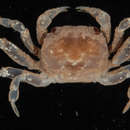en
names in breadcrumbs


Pàng-kì(蟛蜞,hŏk-miàng: Sesarmidae) sê bàng-hâ gì siŏh cṳ̄ng. Pàng-kì-cióng (蟛蜞醬, buô hô̤ lā̤ Pàng-kì-sŭ 蟛蜞酥) cêu sê sāi pàng-kì có̤ gì.
The Sesarmidae are a family of crabs, previously included in the Grapsidae by many authors. Several species, namely in Geosesarma, Metopaulias, and Sesarma, are true terrestrial crabs. They do not need to return to the sea even for breeding.[1]
The family contains these genera:[2][3][4][5]
The Sesarmidae are a family of crabs, previously included in the Grapsidae by many authors. Several species, namely in Geosesarma, Metopaulias, and Sesarma, are true terrestrial crabs. They do not need to return to the sea even for breeding.
Los sesármidos (Sesarmidae) son una familia de cangrejos, previamente incluida en la familia Grapsidae por muchos autores. Varias especies, de los géneros Geosesarma, Metopaulias y Sesarma, son verdaderos cangrejos terrestres. No necesitan volver al mar, incluso para la cría.[1]
La familia contiene los siguientes géneros:[2]
Los géneros Chiromantes, Parasesarma, Pseudosesarma y Sesarmops no son aparentemente monofiléticos. Scandarma puede ser un sinónimo de algún otro género.[1][3]
Los sesármidos (Sesarmidae) son una familia de cangrejos, previamente incluida en la familia Grapsidae por muchos autores. Varias especies, de los géneros Geosesarma, Metopaulias y Sesarma, son verdaderos cangrejos terrestres. No necesitan volver al mar, incluso para la cría.
Les Sesarmidae sont une famille de crabes du groupe des Grapsoidea. Elle comprend plus de 250 espèces.
Ce sont des crabes au mode de vie très terrestres, dont certains sont même arboricoles.
Selon World Register of Marine Species (16 octobre 2017)[1] :
Les Sesarmidae sont une famille de crabes du groupe des Grapsoidea. Elle comprend plus de 250 espèces.
Ce sont des crabes au mode de vie très terrestres, dont certains sont même arboricoles.
Sesarmidae sunt familia brachyurorum, inter Grapsoidea a multis auctoribus antea descripta. Nonnullae species inter Geosesarmam, Metopauliadem, et Sesarmam sunt veri cancri terrestres, qui ad mare ad procreandum redire non debent.[1]
Familiae sunt genera sequentia:[2]
Genera Chiromantes, Parasesarma, Pseudosesarma, et Sesarmops ut videntur non sunt monophyletica. Scandarma fortasse est synonymum iunius (Anglice: junior synonym) alicuius generis.[1][3]
Sesarmidae sunt familia brachyurorum, inter Grapsoidea a multis auctoribus antea descripta. Nonnullae species inter Geosesarmam, Metopauliadem, et Sesarmam sunt veri cancri terrestres, qui ad mare ad procreandum redire non debent.
De Sesarmidae is een familie uit de superfamilie Grapsoidea van de infraorde krabben (Brachyura).
De Sesarmidae omvat volgende geslachten:[2]
De Sesarmidae is een familie uit de superfamilie Grapsoidea van de infraorde krabben (Brachyura).
Cáy hay còn gọi là Cua càng đỏ (Danh pháp khoa học: Sesarmidae) là một họ cua thuộc phân bộ Grapsidae gồm các loại cua đất.[1] Chúng là nguyên liệu cho món mắm cáy.
Cáy cũng có nhiều loại cáy đỏ càng, cáy gió, cáy đen, cáy lông… Con cáy lông nho nhỏ nhưng càng to, các chân nhiều lông, mang của chúng thường có nhiều màu vân[2]. Loài cáy đỏ còng rất dữ, cứ hễ có động là giơ càng để giao chiến, cáy bắt bằng tay thường là loại cáy nâu thân gộp mỏng rất nhiều thịt[3].
Cáy thường sống trong hang các bờ ruộng hoặc bờ mương, bờ sông, nắng càng to thì cáy bò ra khỏi hang tìm thức ăn càng nhiều. Nhưng bắt cáy cũng không phải dễ, bởi chúng rất nhanh, hễ có động là chạy vào hang. Thịt cáy ngọt nên người ta có thể nấu canh, làm mắm ăn dè quanh năm. Trứng cáy có thể rang khô bỏ lọ ăn một tuần. Có nhiều cách đánh bắt cáy, trong đó hai cách bắt cáy thông thường là đi bắt và đi câu[3].
Ở Việt Nam, cáy thường sinh sống ở những vùng nước lợ và đặc biệt nhiều vào thời điểm từ tháng 5 đến tháng 9 dương lịch.
Họ cua này gồm có các chi cua sau đây[1][4][5]
Cáy hay còn gọi là Cua càng đỏ (Danh pháp khoa học: Sesarmidae) là một họ cua thuộc phân bộ Grapsidae gồm các loại cua đất. Chúng là nguyên liệu cho món mắm cáy.
相手蟹科(學名:Sesarmidae)是短尾下目方蟹總科以下的一個科,在之前有多個作者都把本科的物種劃歸方蟹科。當中的吸血鬼蟹屬(Geosesarma)、Metopaulias、相手蟹屬(Sesarma)是真正的陸生蟹,也就是說這些物種繁殖時無需返回海裡[1]。
本科包含以下各個屬[2]:
螳臂蟹屬、擬相手蟹屬、假相手蟹屬及仿相手蟹屬這四個屬似乎並不是單系群。 Scandarma很大可能是其他屬的次異名[1][3]。